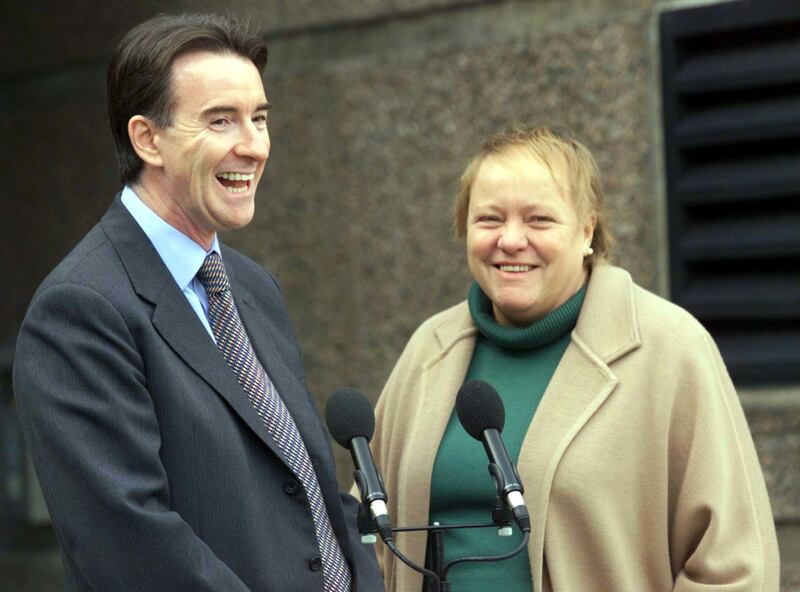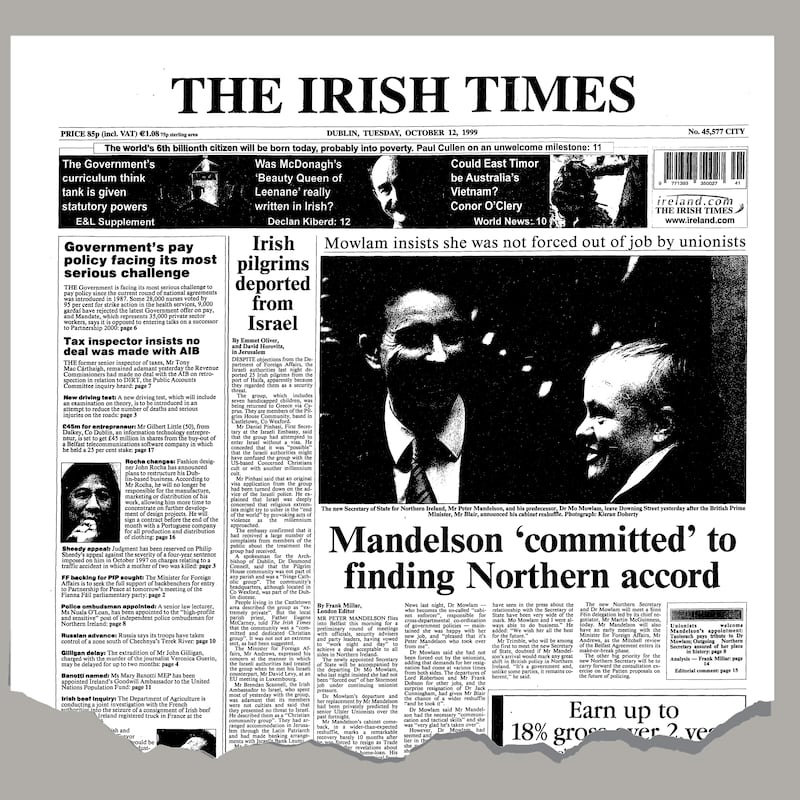After five full days access to many hundreds of hitherto secret Irish government files in the making of the Belfast Agreement, one becomes aware of how complex such working papers must be when dealing with multiparty negotiations.
They cannot be navigated as easily as the annual releases of State papers where the high points will focus on face-to-face summitry between heads of government. And one comes away from the Belfast Agreement files with an awareness that even months of scrutiny would not be sufficient to do them justice.
Researchers will pore over these archives for decades to come. Never before in Irish history – ever – can there have been such a concerted attempt to recast the British-Irish relationship. One senses the ambition, and although it was not so framed, it amounted to nothing less than replacing Lloyd George’s 1921 Quick Fix with John Hume’s 1998 Big Idea.
Lloyd George was a political genius, often likened to a conjuror or a magician. He cared little about the details of any political challenge: rather did he seek a settlement which would “fix” the problem at hand.
READ MORE
Nor had he much concern about consequences. And, in his case – as we throughout Ireland well know – there often were consequences – many of them unintended.
On Ireland, his knowledge of the field of forces that shaped Irish politics was superficial. He had demonstrated this repetitively in the years before 1921. His concern was always to pull the rabbit out of the hat. In this case any rabbit would do, so long as it extricated the Irish Question from British politics.
Not for nothing was he known as the Welsh Wizard. And what Lloyd George accomplished with the 1921 Anglo-Irish Treaty can be characterised as replacing the Irish Question – which had skewed British politics for generations – with what may be called the Ulster Question, which has skewed Irish politics ever since.
The Belfast Agreement was essentially an invitation to the people of all of Ireland – South and North – to admit that Lloyd George’s Ireland was no longer fit for purpose and embrace a braver, fairer and less dysfunctional future as imagined by John Hume. That it would benefit from membership of the European Union as the millennium approached was a bonus.
Hume’s idea was that all sides should be brought to the negotiating table to agree some settlement: he appreciated that such an outcome would necessarily be highly complicated, with many checks and balances to accommodate the competing factions.
The final step would be to have such an agreement endorsed by majorities North and South on the same day, and thus claim a democratic endorsement for Irish self-determination. He believed that this would rebut the claims of those who had resorted to violence based on a shallow reading of the 1918 election.
That the all-island figure of support for the Belfast Agreement was as high as 85 per cent was Hume’s triumph. This was first published on the television coverage of the referendum result – but merely as a prediction as the detail of the separate exit polls, North and South, became available as the ballot boxes closed.
The forecast was confirmed by official returns, which were formally analysed by yet another DFA file. The support in the Republic had been 94 per cent, while North of the Border – with a much more divisive campaign – the agreement had won 71 per cent endorsement, and this with an exceptional turnout with four of every five voters engaged.
Throughout the island no fewer than 85 per cent had endorsed what Hume had been advocating for at least the previous 30 years.
[ John Hume obituary: Nationalist leader who championed ‘agreed Ireland’Opens in new window ]
Was this not a most significant moment in the history of Irish democracy? When before had the inhabitants who lived throughout Ireland agreed on such a fundamental matter? How to govern themselves safely into the future while parking their competing aspirations, which many thought so dangerous that they could trigger a civil war.
Instead these aspirations could now be pursued with mutual respect and without any recourse to violence. As Hume himself had advocated so often, “spilling our sweat instead of our blood”.
How this Belfast Agreement was brought to fruition is to be found in these copious files. They will remain the focus of attention and the preoccupation of scholars for as long as the Irish people wish to be governed by the ballot box rather than the Armalite.
But shaping the agreement and winning the electorate’s endorsement was but the beginning of the work. While some of the participants in the negotiations had wholeheartedly endorsed its spirit: others had merely acquiesced, sometimes reluctantly.
Again the resources of the Departments of the Taoiseach and of Foreign Affairs were deployed and yet more policy files initiated. The depth of the research and the tone of the files are quickly apparent.
For instance, an October 1998 file chronicles a typical day’s talks on the implementation of the agreement. The Irish note taker records that the line adopted by David Trimble for the Ulster Unionists had taken his own colleagues by surprise. Seamus Mallon had described the general atmosphere as “appalling”. In particular, Trimble had spent the first 20 minutes of the afternoon session “tirading” against the North-South Implementation Bodies, with tourism being his special concern.
“How would the identity of Northern Ireland be protected to ensure that it was not ‘swallowed up’ by the South?”
However, the file also recorded that progress was generally being made and credited Sinn Féin’s plausible read on Trimble’s performance. They reckoned that he had probably been filibustering to postpone having to make the “admission that agreement was in sight”.
What the file also noted was that along with his verdict on Trimble, Mallon requested Sinn Féin to cease kicking Trimble, because, as they did, “by extension, they are kicking me”.
Another central question prompted by these files is how chance can have such an influence on historical outcomes. What role did the convergence of Blair and Ahern at the helm in their respective countries play in the making of the Belfast Agreement?
All politicians differ in their intellectual interests; in the challenges they face; and in the opportunities presented. Consider for a moment the very differing incumbents of the Taoiseach’s office ever since the start of the Troubles had exposed Dublin’s threadbare policy on Northern Ireland. To list them is to remind oneself of how they differed: Lynch, Cosgrave, Haughey, FitzGerald, Reynolds and Bruton had all preceded Ahern.
And consider those who were occupants of Downing Street during these same decades: Wilson, Heath, Callaghan, Thatcher and Major had all preceded Blair.
If we turn to the closing of Mo Mowlam’s tenure as Secretary of State and her replacement by Peter Mandelson, this latest tranche of archives is again replete with detail. Blair stated in his autobiography that, as Northern secretary, Mowlam was “fabulous”, citing her temperament and outspokenness as being especially helpful.

Ted Barrington, the Irish ambassador in London, reported to the Anglo-Irish unit in Iveagh House that Mandelson was “a substantial figure”, with “a fine political brain” but also noted that he had shown no great policy interest regarding Northern Ireland.
Barrington expected the new minister to veer towards the unionist position since the change had, he believed, been “in part prompted” by Trimble’s off-the-record call for Mowlam to be replaced by Mandelson.
That Trimble’s Ulster Unionists had lost confidence in Mowlam would be an understatement. At the time they were fond of a particular joke: asking what was the difference between Mandelson and Mowlam as NI Secretary? “Answer: Well Peter Mandelson has actually read the Good Friday Agreement.”
Barrington had also predicted change since it seemed clear to him that, in the aftermath of the Agreement, Blair “had lost confidence in Mowlam’s abilities and felt that he had to take on too much of the burden himself”.
What is more difficult to discern is the extent to which Blair may have been aware at this early stage of Mowlam’s impaired health.

It is now known that she was diagnosed with a brain tumour some months before Blair’s arrival in Downing Street. It is also known that she had attempted to conceal this; and had only turned it into a unique selling point when the tabloids had rumbled her health issues and openly discussed her chemotherapy.
Thereafter she was lionised as a brave campaigner, often winning the room with her trademark unorthodoxy. Not all such details would necessarily be minuted in the diplomatic files but in his memoirs Blair wrote of “the healthy culture shock” of what he calls her “Mo-ness”.
He recalled a particular effect during a difficult period in the negotiations “when she came into my room, took off her wig, slapped it on the table, put her feet on the desk, belched loudly and opined, ‘Well isn’t this a barrel of laughs’”. Blair added that she then proceeded to tell the negotiators that she would prefer at that moment to be engaged in many other pursuits, instancing “vigorous sexual intercourse”.
Dr John Bowman is a broadcaster and historian. His De Valera and the Ulster Question: 1917–1973, won the Ewart-Biggs Prize for its contribution to North-South understanding. He has written each year for the past 40 years on the release of State papers for The Irish Times.



















